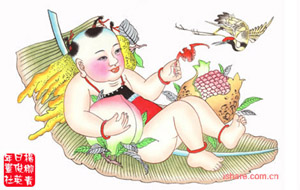 |
After the Tang Dynasty, some works evolved into more realistic pictures, and the images of the door-gods turned into two generals: Qin Qiong and Yuchi Jingde. There were more nianhua produced in this fashion in the Song Dynasty (960-1279 A.D.), and xylographic nianhua, of religious themes developed gradually in the Ming Dynasty (1368-1644 A. D.).
In the Ming and Qing dynasties, xylographic nianhua reached a new height of development and nianhua came into the homes of the ordinary people. In the Qing Dynasty, most of the provinces had their own workshops for making nianhua.
The main producers included Taohuawu of Suzhou, Yangliuqing of Tianjin, Weifang of Shandong, Foshan of Guangdong, Mianzhu of Sichuan, Wuqiang of Hebei, Zhu-xianzhen of Henan, Shaoxing of Zhejiang, and so on.
Judging from their development, there are two schools of nianhua: the southern school and the northern school.
